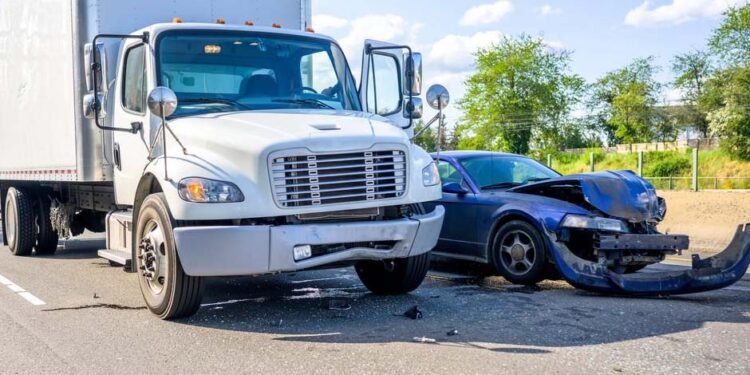Navigating the aftermath of semi-truck accidents often necessitates traversing complex legal landscapes. This exploration scrutinizes the intricacies of such cases, shedding light on the role of injury severity, liability determination, industry regulations, and evidence collection in shaping compensation outcomes.
Further, it delves into the average settlements and awards to provide a comprehensive understanding of semi-truck accident compensation, underpinning the criticality of astute legal guidance and pre-settlement funding considerations.
Key Takeaways
– Average settlements and awards for semi-truck accidents can vary depending on the severity of the injuries and the specific circumstances of the case.
– It is crucial to collect evidence throughout the recovery process to support a truck accident claim and increase the chances of receiving fair compensation.
– The timeline for settling minor and severe injury claims can differ, with severe injury claims typically taking longer due to the need for extensive medical treatment and rehabilitation.
– Property damage claims resulting from a truck accident are typically handled separately from personal injury claims.
Understanding the Concept of Semi-Truck Accident Compensation
Understanding the concept of semi-truck accident compensation involves a comprehensive analysis of average settlements and awards. This analysis requires meticulous consideration of various factors such as the severity of injuries, property damage, and the extent of negligence on the part of the truck driver or other liable parties.
Factors affecting the calculation of compensation in semi-truck accident cases include, but are not limited to, the physical, emotional, and financial impact on the victim. Challenges in securing fair compensation for semi-truck accident victims can arise due to legal complexities, such as proving the degree of negligence, or the intricacies of trucking regulations.
Therefore, an in-depth understanding of these elements is crucial in the preparation and presentation of a compelling case for semi-truck accident compensation. This is where you will need the expertise of a truck accident law firm near you.
The Severity of Injuries and Their Impact on Compensation
The gravity of injuries sustained in vehicular mishaps significantly influences the amount of remuneration awarded to victims, with more severe injuries typically yielding higher monetary settlements. This correlation is particularly notable in cases involving traumatic brain injuries and wrongful death lawsuits where compensation can reach substantial amounts.
| Injury Type | Average Compensation |
| Minor Injuries | Low to Medium |
| Severe Injuries | Medium to High |
| Traumatic Brain Injuries | High |
| Paralysis | Extremely High |
| Wrongful Death | Maximum |
It is crucial to understand the connection between injury severity and compensation in order to navigate the legal landscape effectively. This understanding can aid in the formation of effective legal strategies and ensure victims receive the compensation they rightfully deserve.
Identifying Responsible Parties in Semi-Truck Accidents
Identifying responsible parties in large vehicle collisions involves examining various potential culprits, such as drivers who may have violated traffic laws or trucking regulations, as well as other entities like truck owners, employing firms, defective parts manufacturers, and cargo businesses. These parties could be held liable for damages and subject to wrongful death lawsuits in fatal cases.
The prevalence of liability insurance policies among different parties can contribute significantly to the compensation for injuries.
A thorough investigation is necessary to uncover additional liability insurance policies.
The complexity of liability determination underscores the need for legal expertise in such cases.
Victims’ rights are paramount, and all responsible parties should be held accountable.
This comprehensive approach ensures justice for victims while reinforcing traffic safety regulations.
The Role of Trucking Regulations and Duty of Care in Compensation Cases
Regulations governing the operation of large vehicles play a crucial role in maintaining safety standards and are often considered in legal cases involving traffic collisions. As part of the duty of care, these regulations aim to ensure safety and enforce industry standards. Violations can establish negligence, influencing compensation awards in semi-truck accident cases.
| Regulation | Purpose | Impact on Compensation |
| Driver Eligibility | Ensures only qualified individuals operate trucks | Violations can contribute to negligence |
| Truck Maintenance | Guarantees vehicles are safe for use | Improper maintenance can lead to liability |
| Cargo Capacity | Prevents overloading, ensuring stability | Exceeding limits can indicate negligence |
| Driving Hours | Prevents fatigue-related accidents | Breaches can justify higher compensation |
| Alcohol and Drug Policies | Ensures driver fitness for duty | Violations can establish liability |
In essence, trucking regulations and the duty of care play a pivotal role in both ensuring safety and determining compensation in semi-truck accident cases.
The Importance of Evidence Collection in Semi-Truck Accident Cases
Evidence collection plays a crucial role in legal proceedings involving large vehicle collisions, often serving as the backbone of a successful claim. The process of gathering pertinent information and evidence is imperative to:
- Uncover details that enhance an understanding of the incident
- Provide a robust foundation for proving negligence
- Facilitate the process of recovering medical expenses
- Bolster the credibility of claims made
In cases of semi-truck accidents, it is essential to meticulously document the incident, gather information about the truck driver, and collect evidence from the scene. This includes photographs, videos, and witness statements. Furthermore, evidence that attests to regulatory violations can be a significant determinant in negligence proof.
In essence, the task of evidence collection is a pivotal process in ensuring fair compensation.












